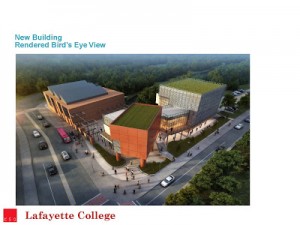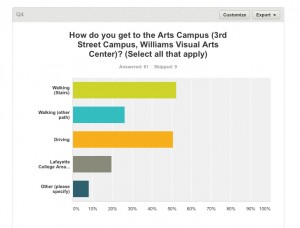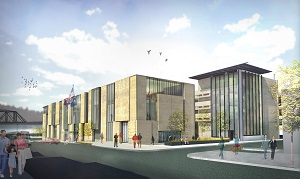Social Context
Lafayette College is in the process of expanding the Third Street Campus. The Third Street Campus is currently composed of two buildings, Williams Visual Arts Center and the 248 North Third Street building. Lafayette has recently broken ground on a third building, located at 219 North Third Street, which is scheduled to be completed December 2015 (Lafayette College, 2014). With the additional buildings comes additional students frequenting the Third Street Campus. It is essentially that the school provides a safe, accessible and sustainable passageway for these students.
There have been several inquiries into the Third Street Connection prior to this year’s Engineering Studies Capstone Project. There was a Technology Clinic report, written in 2004 that addressed the traffic, transportation, and development of the North Third Street Campus. The Technology Clinic framed the problem as “There is currently little incentive for students to frequent the area due to the lack of useful commercial establishments. These incentives are further decreased by other difficulties presented to the students, which include the physical exertion, psychological inhibition, and weather difficulties involved with transit on the hill” (Technology Clinic, 2004). Half of this statement is no longer true; students do have an incentive to frequent Third Street. Most film and medias studies classes as well as all studio art classes are held on the Third Street Campus. In addition to this, there have been many events held on Third Street. The Technology Clinic came up with three solutions for the Third Street Connection.
The first solution was a shuttle bus, which is now known as the Arts Campus LCAT. The technology clinic discussed how the shuttle bus would not be appealing to students who already drive and that “overall, the shuttle would likely not be an appealing means of transportation for the students faculty and visitors of the college” (Technology Clinic, 2004). The second solution they came up with was an elevator. The elevator would be a fast means of transportation to the Third Street Campus, as well as a more flexible means of transportation for the rider (Technology Clinic, 2004). The Technology Clinic concluded, “If there were a walkway/bridge built out to a freestanding elevator shaft, the result would be an eyesore. It would ruin the clear view that visitors and students have up the hill to the statue” (Technology Clinic, 2004). The third solution that the Technology Clinic proposed was a funicular, which is an overland rail-bound transport (Technology Clinic, 2004). “Funiculars are fast, allowing students and faculty reliable and unrestricted access to Third Street…Funiculars are also very visually appealing, and bring with them an element of prestige” (Technology Clinic, 2004).
This report provided a lot of information on the different alternatives for the Third Street Connection, however very little was done after the report was released. One of the recommendations that the report did make, which Lafayette followed, was that the Third Street Campus be built up slowly so that the school could determine what the demand for the connection was (Technology Clinic, 2004).
In addition to the Technology Clinic Report, in 2006, Michelle Oswald did an independent study titled, “The Accessibility of Third Street from College Hill”. Oswald addressed the route length, lighting, landscape, and sidewalk conditions. Oswald came up with both short term and long term goals. Some of her recommendations, such as increasing the number of lamp posts along the stairs were implemented by the college. However, some of Oswald’s long term recommendations such as “[Reducing] the ramp length and slope alone the steps” were not met (Oswald, 2006). Unfortunately when both of these reports were done, there was less of a demand for the connection between the Third Street Campus and the Main Campus because of the lack of development along Third Street.
However, the current Third Street Campus is being built up and developed. The current arts campus is being expanded to include the 219 N. Third street property. This property will include a black box theater, a box office, a cinema and classrooms. This project is projected to be completed December of 2015. This additional building creates a higher demand for a safe and efficient way to reach the arts campus.

In a survey of 70 students, 45% of the students said they have never been to the Third Street Campus. In that same survey when asked why students have never taken a class at the Third Street Campus, 32% of respondents said it was too far. Only 20% of the respondents said they have taken the LCAT to get to the Third Street Campus. 78% of the respondents said they walk to the Third Street Campus, either by the steps or an alternative path. The LCAT is clearly not the preferred way to access the Third Street Campus. It is encouraging to see that students prefer walking. Lafayette should be working to become a more sustainable campus.

This is a historical moment for the college and an opportunity for us to make a long-term impact on Lafayette’s campus. The college should be invested in providing sustainable solutions in order to keep up with other college’s trends. On our own campus there have been significant development projects to turn Lafayette into a walking campus. Although an elevator or a funicular is the “easiest” way up the hill, it is not a good solution in terms of sustainability. Being able to redo the stairs at a normal grade and tread with handrails could be both a simple and sustainable solution, which students will accept.
The school is currently going through a lawsuit following the tragic accident involving Aubrey Baumbach. Aubrey was hit by a vehicle while walking along Easton Road (Cassi, 2014). The suit claims the school did not provide transportation to the boathouse, a safe passageway to get there, or enough parking for students who drove there (Cassi, 2014). Similar claims could be made against the current connection to the Third Street Campus. Although Lafayette does provide transportation via the LCAT, the current steps under certain weather conditions, could be considered an unsafe passageway. It is essential that the school does everything it can to provide a safe pathway to the Third Street Campus. After a phone call with Plant Operations, it became apparent that the current stairs to the Third Street Campus get covered with leave in the fall. When it rains, the stairs are very difficult to safely walk down. In addition to this, Plant Operations said that one of the steps is loose. With the deteriorating circumstances of the steps, the impending lawsuit, and the increased traffic to the Third Street Camps, it is clear that there needs to be a better connection.
In terms of the image the college would like to portray, the connection to the Third Street campus is also important. A vibrant arts campus would help Lafayette’s reputation in the Easton community as well. Lafayette seems to physically look down on the city, and students rarely support the businesses downtown. A seamless transition would help change that and would promote the patronizing of Easton downtown business by Lafayette students.
Easton is currently revitalizing itself and bringing many events and festivals to downtown. These events are great ways bring people to Easton, and help support the local community. Lafayette should be invested in helping link Easton and Lafayette. If Easton becomes a more attractive place to live, Lafayette will become a more attractive college to attend. Investment in the stairs is an investment Easton and the future of Lafayette.
Easton is currently building a new Easton City Hall and Transportation Center. Salvatore Panto Jr., the mayor of Easton, said “This garage is the latest in the series of urban development projects that are making our city safer, more beautiful, and more successful. We are looking forward to the economic opportunities a new City Hall complex will bring to Easton, We are also excited to have Spillman Farmer on board, as they have designed many successful urban development projects in Easton, such as the Sigal Museum and the Lafayette College Arts Plaza”(Spillman Farmer Architects, 2014). The design for the new city hall is inline with the style of the Third Street Campus, and is actually located on the other end of Third Street. This new city hall will lend a visual connection between the City of Easton and Lafayette College.

Lafayette recently launched a new development campaign called “Live Connected Lead Change” (Lafayette College Office of Development, 2014). The campaigns goal is to raise 400 million dollars for the Lafayette campus and community. The introduction for the campaign states, “In a world increasingly shaped by connections between people, across disciplines, and among nations, those capable of fostering and leveraging such connectivity will be positioned to succeed – and to lead. At Lafayette, we live connected. And because we live connected, we are prepared to lead change”(Lafayette College Office of Development, 2014). The campaign is clearly advocating for connections on campus. This is an optimal time to discuss what the Third Street Connection should look like. Of the 400 million dollars, 20 million is being allocated to the “Williams Arts Campus” (the Third Street Campus). It is imperative that the college invests in not only the campus, but also invests in the Campus connection.
The issue of the hill is not going to change; this is a permanent issue that the school is going to face. We need to come up with a sustainable solution that students will use. Students seem to use the current stairs regardless of their current state. We need to make improvements to the stairs so that they are safe and accessible. Lafayette has invested tens of millions of dollars in the Third Street Campus. Its time to invest in the Stairs. With the current development campaign, the school is in a great position to undertake this project. It does not make sense to call our campus a connected community when the campus is not physically connected to Third Street.

Leave a Reply